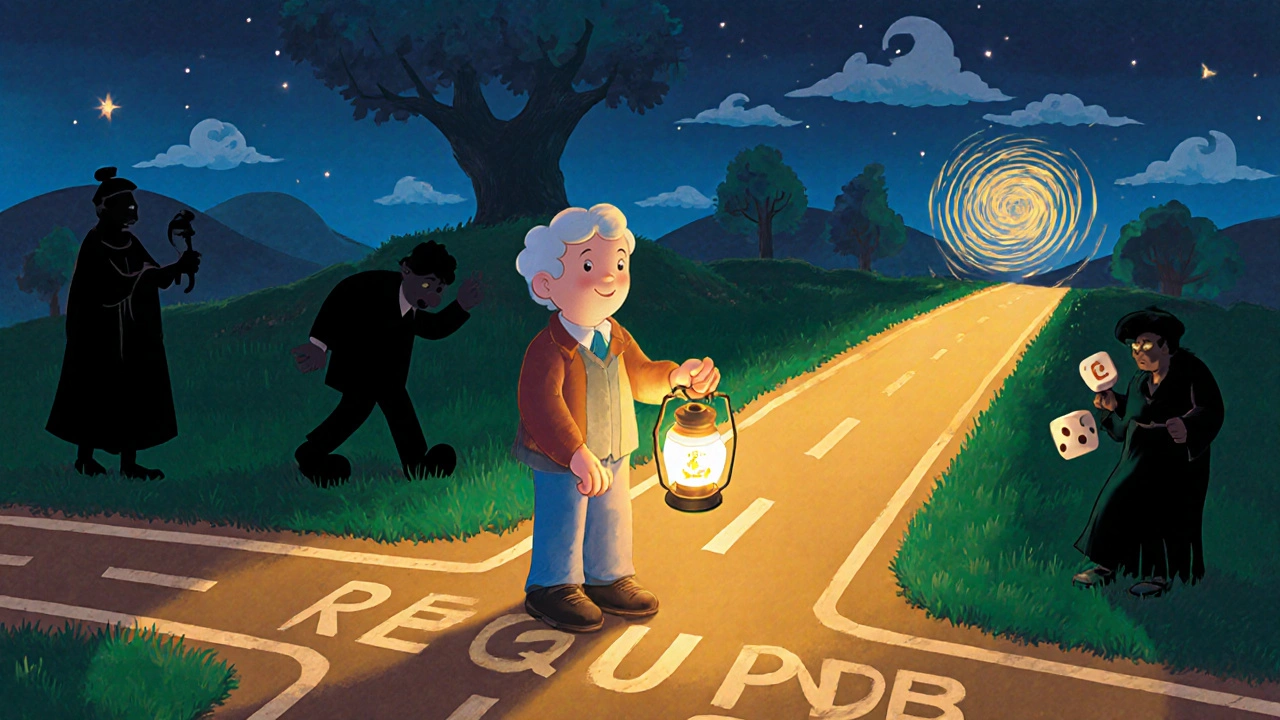Requip is a brand name for ropinirole, a medication that mimics the effects of dopamine in the brain. It’s not a cure, but it helps manage symptoms of two neurological conditions: Parkinson’s disease and moderate to severe restless legs syndrome (RLS). If you’ve been prescribed Requip, you’re likely looking for clear, no-fluff answers about how it actually works, what to expect, and whether it’s right for you.
How Requip Works in the Brain
Dopamine is a chemical messenger that helps control movement, mood, and reward systems. In Parkinson’s disease, the brain slowly loses the cells that produce dopamine. This leads to tremors, stiffness, slow movement, and balance problems. Requip doesn’t replace dopamine - it tricks dopamine receptors into thinking dopamine is present. This helps reduce those movement symptoms.
For restless legs syndrome, the cause isn’t fully understood, but low dopamine activity in the spinal cord is strongly linked to the uncomfortable urge to move your legs, especially at night. Requip helps calm that signal, which is why many people report better sleep after starting it.
Requip is a dopamine agonist - meaning it binds directly to dopamine receptors. Unlike levodopa (another Parkinson’s drug), it doesn’t need to be converted into dopamine first. This makes it useful for early-stage Parkinson’s or as a long-term add-on. But it’s not a magic fix. It won’t stop the disease from progressing, only help you manage it better.
Who Prescribes Requip and Why
Requip is typically prescribed by neurologists or movement disorder specialists. It’s not something your GP will hand out without a referral. Two main groups get it:
- People with Parkinson’s disease - often in the early stages, or when levodopa causes side effects like involuntary movements (dyskinesia). Requip can delay the need for levodopa or reduce its dose.
- People with restless legs syndrome - especially when symptoms disrupt sleep, happen more than three times a week, and aren’t helped by lifestyle changes like cutting caffeine or walking before bed.
It’s not used for other types of movement disorders, depression, or general fatigue. If your doctor says you have RLS, they’ll usually try non-drug methods first. Requip is for when those don’t cut it.
Dosing: Start Low, Go Slow
Requip comes in immediate-release tablets and extended-release tablets. The dosing is very different for Parkinson’s versus RLS.
For restless legs syndrome, most people start at 0.25 mg once a day, 1-3 hours before bedtime. The dose is slowly increased, usually by 0.25 mg every few days, until symptoms are controlled. Most people stay between 0.25 mg and 4 mg per day. Higher doses don’t always mean better results - and can mean more side effects.
For Parkinson’s, the starting dose is even lower: 0.25 mg three times a day. It’s increased weekly, often up to 8-16 mg daily, split into three doses. Some people need up to 24 mg a day, but that’s rare.
The extended-release version (Requip XL) is taken once daily and gives steady levels over 24 hours. It’s often used for Parkinson’s patients who struggle with multiple daily doses.
Never change your dose without talking to your doctor. Too much can cause sudden sleep attacks. Too little won’t help.
Side Effects: What to Watch For
Most people tolerate Requip okay, but side effects are common - especially when starting or increasing the dose.
- Dizziness or lightheadedness - especially when standing up. This is due to low blood pressure. Sit or lie down if you feel faint.
- Nausea - the most frequent complaint. Taking it with food helps a lot.
- Drowsiness or sudden sleep episodes - this is serious. People have fallen asleep while driving, talking, or eating. If you’ve ever dozed off unexpectedly, tell your doctor immediately.
- Headache, fatigue, or constipation - mild but common.
- Impulse control problems - this is less known but critical. Some people develop uncontrollable urges: gambling, shopping, binge eating, or hypersexuality. These can be dangerous and aren’t always recognized as drug-related. If you notice new behaviors you can’t control, stop the medication and call your doctor.
These side effects are more likely in older adults and those with a history of addiction or mental health conditions. Requip isn’t safe for everyone.

Who Should Avoid Requip
Requip isn’t for everyone. You should not take it if:
- You’re allergic to ropinirole or any ingredient in the tablet
- You have severe liver disease - your body can’t clear the drug properly
- You’re taking certain antipsychotics like haloperidol or risperidone - they block dopamine and cancel out Requip
- You’re pregnant or breastfeeding - there isn’t enough safety data
- You’ve had a previous reaction to dopamine agonists
If you have heart problems, low blood pressure, or a history of mental illness, your doctor will need to monitor you closely. Requip can make hallucinations or psychosis worse in people with Parkinson’s dementia.
What Happens When You Stop
Never stop Requip suddenly. If you do, you can get a dangerous condition called dopamine agonist withdrawal syndrome (DAWS). Symptoms include severe anxiety, panic attacks, depression, insomnia, nausea, sweating, pain, and even suicidal thoughts. These can last for weeks.
If you need to stop - whether because of side effects or because your doctor recommends it - the dose must be lowered slowly over weeks or months. Your doctor will give you a tapering schedule. Don’t try to do it on your own.
Requip vs. Other RLS and Parkinson’s Drugs
There are other options, and choosing between them depends on your symptoms, age, and other medications.
| Medication | Used For | Key Advantage | Key Risk |
|---|---|---|---|
| Requip (ropinirole) | Parkinson’s, RLS | Good for early Parkinson’s; helps RLS without iron supplements | Sudden sleep attacks; impulse control issues |
| Levodopa (Sinemet) | Parkinson’s only | Most effective for movement symptoms | Long-term use causes dyskinesia (involuntary movements) |
| Pramipexole (Mirapex) | Parkinson’s, RLS | Similar to Requip; longer half-life | Higher risk of impulse control disorders |
| Gabapentin Enacarbil (Horizant) | RLS only | No dopamine-related side effects | Drowsiness, dizziness; not for Parkinson’s |
| Pregabalin (Lyrica) | RLS (off-label) | Helps nerve pain; good for RLS with pain | Weight gain, swelling, dizziness |
Requip is often chosen over pramipexole because it’s slightly less likely to cause impulse control problems. But if you’re older or have kidney issues, gabapentin enacarbil might be safer. There’s no single best drug - it’s about matching the drug to your life.

What to Do If Requip Isn’t Working
If you’ve been on Requip for 4-6 weeks at the right dose and still have symptoms, talk to your doctor. Don’t just increase the dose yourself.
For RLS: Your doctor might check your iron levels. Low ferritin (even with normal blood iron) is a common hidden cause. If your ferritin is below 50 mcg/L, iron supplements may help more than increasing Requip.
For Parkinson’s: If symptoms are worsening, your doctor might add levodopa, or switch to a different dopamine agonist. Sometimes, deep brain stimulation becomes an option if medications aren’t enough.
Also, check your sleep habits. Poor sleep, caffeine after noon, or alcohol can make RLS worse - even if you’re on medication.
Real-Life Experience: What Patients Say
One patient in her 60s with RLS said: "I was lying awake every night, feeling like ants were crawling under my skin. After two weeks on Requip, I slept through the night for the first time in years. But I started gambling online - something I’d never done before. I didn’t connect it until my daughter pointed it out. I told my doctor, and we cut the dose. The gambling stopped. I still take half the dose - and I still sleep fine."
Another man with Parkinson’s said: "I started Requip when I was 55. It kept me walking without shaking for five years. Then I began falling asleep in the middle of conversations. My job was in customer service. I had to quit. We switched to levodopa. I still have tremors, but I’m awake."
These stories aren’t rare. Requip helps - but it comes with trade-offs. The key is staying alert to changes in your behavior, mood, and sleep.
Can Requip cause weight gain?
Weight gain isn’t common with Requip, but some people report it. This is usually linked to increased appetite or reduced physical activity due to fatigue. It’s not a direct effect like with some antidepressants. If you notice unexplained weight gain, talk to your doctor - it could be a sign of other issues like fluid retention or hormonal changes.
Is Requip addictive?
Requip isn’t addictive in the way opioids or benzodiazepines are. You won’t crave it for a high. But your body can become dependent on it. Stopping suddenly can cause withdrawal symptoms. That’s why tapering is essential. Also, the impulse control problems it can cause - like compulsive gambling - have addictive-like behaviors. These aren’t about the drug being pleasurable; they’re about brain circuit changes.
Can I drink alcohol while taking Requip?
It’s best to avoid alcohol. Alcohol increases drowsiness and dizziness - two side effects Requip already causes. Together, they raise your risk of falling, passing out, or having a sudden sleep attack. Even one drink can make you unsafe to drive or operate machinery.
How long does it take for Requip to start working?
For restless legs syndrome, most people notice improvement within a week, especially if they’re taking it at night. For Parkinson’s, it can take 2-4 weeks to feel the full benefit. Dose adjustments are made weekly, so don’t expect instant results. Patience is key - but if you feel worse after two weeks, contact your doctor.
Is there a generic version of Requip?
Yes. Ropinirole is available as a generic, and it’s much cheaper than the brand-name Requip. The FDA says generics are just as safe and effective. Many insurance plans push for the generic unless there’s a medical reason not to. Ask your pharmacist if you’re paying too much.
Next Steps If You’re on Requip
If you’re taking Requip, here’s what to do next:
- Keep a symptom diary - track your RLS or Parkinson’s symptoms daily. Note when they’re worse and if side effects appear.
- Ask your doctor to check your ferritin level if you have RLS. Low iron is a common hidden trigger.
- Watch for sudden sleep episodes. Tell someone close to you to alert you if you nod off unexpectedly.
- Monitor your behavior. Are you spending more money than usual? Gambling? Eating compulsively? These are red flags.
- Never skip a dose or stop cold turkey. Always taper with your doctor’s guidance.
Requip can be life-changing - but only if you use it wisely. It’s not a simple pill. It’s a tool that requires awareness, communication, and careful management. If you’re on it, you’re not just taking medication - you’re managing a delicate balance in your brain. Stay informed. Stay alert. And never ignore the signs your body is giving you.


Jenny Lee
November 19, 2025 AT 17:52Been on Requip for RLS for 3 years. Sleep is finally normal. No gambling, no sleep attacks. Just take it at night, don't mess with alcohol, and boom - life changes. 🙌
Jeff Hakojarvi
November 20, 2025 AT 16:00Hey, just wanted to add - if you're on Requip and feel weirdly tired or zone out during conversations, DON'T ignore it. I almost crashed my bike because I nodded off pedaling home. Told my neurologist, we dropped the dose by half, and now I'm fine. Seriously, sudden sleep = red flag. Talk to your doc before it's too late.
Ancel Fortuin
November 20, 2025 AT 20:20Of course the pharma giants love Requip - it keeps you dependent, creates ‘impulse disorders’ so they can sell you more drugs for those, and then you’re stuck paying $200 a month for a pill that just makes you sleepwalk through life. Wake up people - this isn’t medicine, it’s corporate control disguised as relief.
mithun mohanta
November 20, 2025 AT 23:06Let’s be real - Requip is the dopamine agonist equivalent of a luxury sedan: sleek, powerful, and absolutely terrifying if you don’t know how to handle it. The impulse control side effects? That’s not a bug - it’s a feature of neurochemical recalibration. Most patients can’t even articulate the existential dissonance they experience when their dopamine receptors start rewiring their identity. It’s not just ‘gambling’ - it’s the collapse of the ego’s moral scaffolding. And yet, the medical community still treats it like a side effect checklist. Pathetic.
Hannah Blower
November 22, 2025 AT 14:11Oh wow, another person who thinks dopamine agonists are ‘safe’ because they don’t make you high? Please. You’re not ‘managing’ RLS - you’re outsourcing your willpower to a molecule. Requip doesn’t fix anything - it just silences the symptoms while your brain quietly unravels. And don’t get me started on how the DSM ignores the psychological erosion these drugs cause. You’re not ‘on medication’ - you’re in a slow-motion chemical hostage situation.
Gregory Gonzalez
November 23, 2025 AT 10:13Wow. So Requip helps you sleep… but also makes you bankrupt and unconscious? What a bargain. I’m sure the FDA’s ‘risk management program’ is just a cute little pamphlet titled ‘Sorry, Your Soul Got Replaced.’
Timothy Uchechukwu
November 23, 2025 AT 12:49In Nigeria we don’t even have access to this stuff. People suffer with RLS and no one cares. Meanwhile you Americans are arguing about whether your dopamine is being manipulated by Big Pharma. First world problems. Just walk barefoot on grass and pray like your ancestors did.
Emily Entwistle
November 23, 2025 AT 20:34I had the gambling thing happen too 😔 I thought I was just stressed, but my husband found my credit card statements. We told the doctor, cut the dose, and now I’m back to reading books at night. Requip saved my sleep but almost stole my life. Be careful out there 💔
Ram tech
November 24, 2025 AT 05:33requip? sounds like a typo for 'rip off'. why not just drink a beer and call it a night? also why do doctors always start at 0.25mg? like… are they scared of the number 1?
Samkelo Bodwana
November 25, 2025 AT 20:49I’ve been on both Requip and pramipexole. Honestly? Requip’s impulse control issues are real, but pramipexole made me feel like I was slowly turning into a zombie who only wanted to buy things on Amazon. I switched back to Requip at half the dose, added iron supplements (ferritin was at 18), and now I sleep like a baby without the compulsive spending. It’s not perfect - nothing is - but it’s a balance. We’re not robots. We’re humans trying to manage broken biology with imperfect tools. Maybe we need to stop seeing these drugs as villains or saviors and just treat them as tools that need careful handling. And yes - talk to your doctor before you change anything. Seriously.
Duncan Prowel
November 26, 2025 AT 04:27One must question the epistemological validity of attributing complex neuropsychiatric phenomena to monoaminergic modulation alone. While pharmacological intervention may ameliorate symptomatic expression, it does not address the ontological dissonance inherent in the human condition when subjected to exogenous dopaminergic stimulation. The reductionist paradigm underpinning Requip’s clinical deployment reflects a broader medical hegemony that pathologizes natural variability. One wonders whether the true pathology lies not in the disease, but in the therapeutic imperative itself.
Jeff Hakojarvi
November 27, 2025 AT 02:22Just saw someone say Requip is 'Big Pharma' - I get it, but I also know a guy who couldn’t walk without shaking until he started it. Then he drove his grandkids to school again. It’s not perfect, but it gave him back his life. We need to stop seeing drugs as evil or magic. They’re tools. Like a hammer - can build a house or break a skull. It’s how you use it.